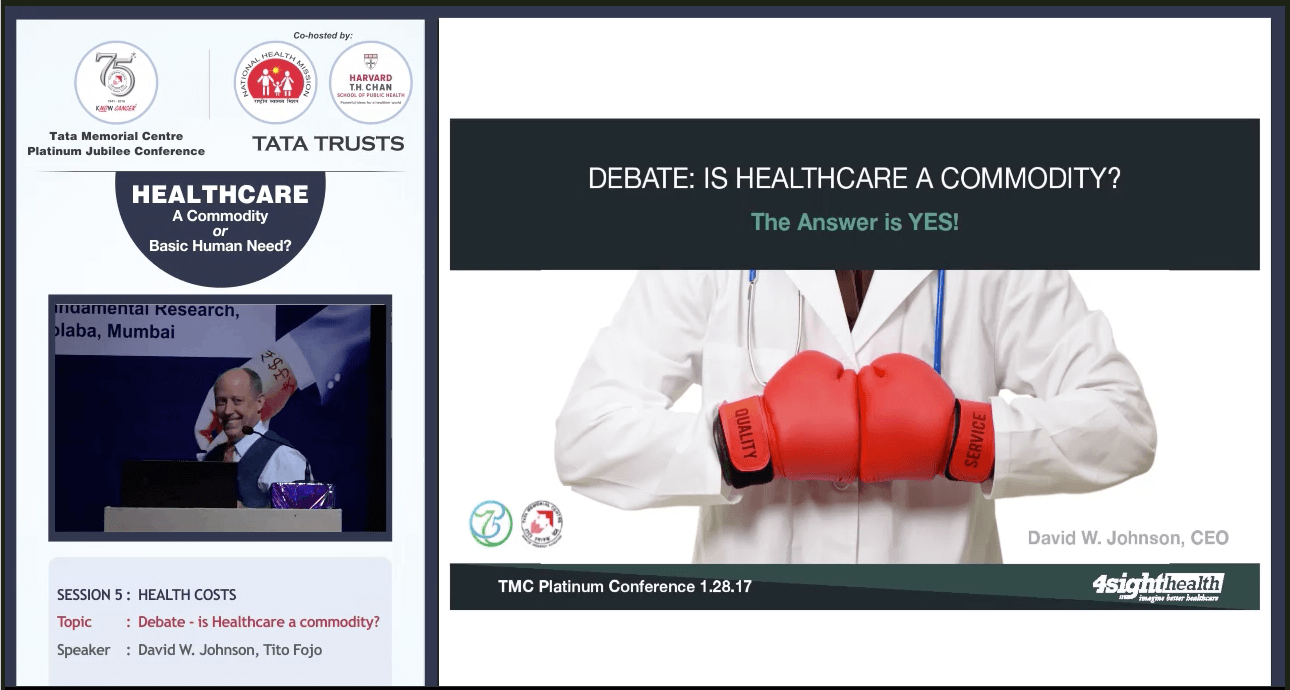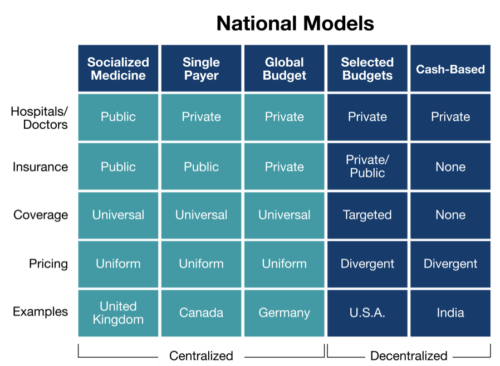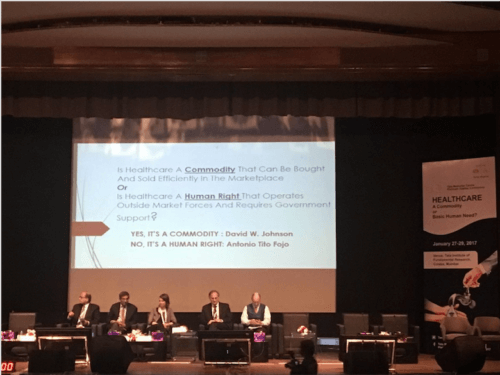March 22, 2017

AHA! Healthcare Is Both a Right and a Commodity
In late January, I participated in an Oxford-style debate regarding whether healthcare is a commodity. The debate was the featured event at Tata Memorial Centre’s Platinum Jubilee Conference in Mumbai, India.
A packed auditorium of over a thousand attendees buzzed with excitement as Professor Antonio “Tito” Fojo (my opponent) and I walked on-stage. The conference theme, “HEALTHCARE: A Commodity or Basic Human Need?” put the spotlight on our contest. We were midway through the 3-day conference, and it was show-time.
Dr. Benjamin Anderson moderated our debate. Dr. Anderson is a respected global health leader and currently chairs The Breast Health Global Initiative at the Fred Hutchinson Cancer Research Center in Seattle, Washington. Ben, Tito and I became fast friends as we prepared for the debate.
My role was to argue in favor of the motion that healthcare is a commodity. Tito is a world-renown cancer researcher and gifted public speaker. As we waited for introductions, he whispered that I had “drawn the short straw.” Tito was more right than he could have imagined.
Ben conducted the pre-debate vote. Only three audience members agreed with the proposition that healthcare is a commodity. In overwhelming numbers, the audience asserted that healthcare is a basic human need and right. Stepping up to the podium, I clearly had some explaining to do.
Rhetoric and Reality
Ironically, making healthcare a right doesn’t translate into universal healthcare access. Far from it. In rich and poor counties alike, societies struggle to provide appropriate care at appropriate prices. The United States spends far more per-capita on health expenditure than any other country, but has significant over-utilization along with sizable coverage and access gaps.
At the other end of the economic spectrum, the Indian Constitution proclaims healthcare is a basic human right for its citizens. Despite this, India has enormous unmet medical needs and limited insurance coverage. 70% of Indian healthcare transactions occur on a cash “pay as you go” basis.
Throughout the world, societies provide and pay for healthcare services. Their healthcare policy debates center on the appropriate role for government in service delivery, payment, guaranteeing access and regulating market participants.
No national health system is perfect. All struggle to manage demand for healthcare services, provide equitable access and control costs. Absent transformation, healthcare will consume disproportionate amounts of national resources in all countries without commensurate increases in national wealth.
The chart below summarizes the five different models that nations use to distribute healthcare services. These models are broad categorizations. Within countries, health systems exhibit nuanced differences and may incorporate features from multiple models.

The Healthcare Anomaly
Scottish philosopher and economist Adam Smith published The Wealth of Nations in 1776. In his treatise, Smith explained how the market’s “invisible hand” allocates resources more efficiently and thereby creates wealth. Smith’s theories created the conceptual foundation for modern capitalism.
As Smith prophesized, de-centralized free-market systems consistently outperform centrally-planned economic systems. Capitalist economies allocate resources more effectively and more efficiently than market socialist economies. Capitalism’s higher productivity generates disproportionate national wealth. Capitalist South Korea’s economic prosperity dwarfs that of socialist North Korea.
While capitalism has thrived in the manufacturing, wholesaling and retailing sectors, it has under-performed in healthcare. To date, centralized systems have generated superior health status for lower costs than decentralized systems. Does this mean that the healthcare industry is fundamentally different than other industries and operates outside the boundaries of established economic theory?
The consequences of market failure in healthcare can lead to serious injury or even death. With stakes this high, most advanced economies centrally plan, price and regulate healthcare services. Examples include socialized medicine (Great Britain), single-payer systems (Canada) and global healthcare budgeting (Germany).
Centralized systems coordinate healthcare service provision and payment. Prices are uniform and coverage extends to all citizens. Implicit in this preference for centrally-administered healthcare is the belief that highly-regulated, government-led healthcare delivery is more reliable and efficient than free-market approaches.
Proponents of centrally-administered health systems argue that healthcare differs from other businesses in the following important ways:
- Buyers and sellers of healthcare services do not have complete (and perfect) information when executing transactions, so they cannot make meaningful judgements regarding the quantity, prices and relative benefits of specific healthcare products.
- The existence of “externalities” (e.g. the costs of training doctors) expands the benefits and costs of healthcare transactions beyond buyers and sellers.
- Uncertainty related to healthcare symptoms, treatment and outcomes complicates service pricing. Stomach pain could result from indigestion or a cancerous tumor.
- Adverse selection in the purchasing of healthcare insurance distorts market participation. Those who require healthcare services disproportionately buy health insurance coverage.
- A small percentage of the population consumes a disproportionate share of healthcare expenses. In the United States, for, example, 5% of patients consume 50% of total health expenditures.
- Moral hazard and “free-riding” in receiving healthcare services wastes resources. Many patients consume far more healthcare services than they require, particularly when third-parties pay for the consumed services.
- There is significant information asymmetry. Doctors and caregivers know more than patients, which can lead to passive acceptance of medical recommendations or unrealistic distrust.
- Perverse financial incentives stimulate over- and under-treatment.
- Those who cannot pay for healthcare services forgo necessary treatments.
- Monopolistic/predatory pricing can occur when vital healthcare products (e.g. drugs) and services are in scarce supply.
There are examples of healthcare services (e.g. ophthalmology) with transparent pricing and great customer service. It’s easy and affordable to get eye check-ups and buy glasses, even on nights and weekends. Such services are the exception; however, not the rule.
From all apparent evidence, it seems reasonable to deduce that centralized systems allocate scarce healthcare resources more efficiently and effectively than de-centralized health systems. Deductive logic is powerful, but not always accurate.
The flaws in healthcare markets identified above are real, but also exist in other markets to greater and lesser degrees. Economists use regulation to mitigate these flaws, balance supply-demand relationships and create level competition.

There’s Danger in Deductive Reasoning
Another Scottish philosopher from the 1700s, David Hume, found fault with “if-then” deductive reasoning. Hume believed in the power of data-driven inductive reasoning and used just-discovered black swans to illustrate his logic.
That there were no recorded sightings of black swans, Hume observed, did not negate their existence. To the contrary, the sighting of just one black swan proved that not all swans were white.
As the penguin cartoon illustrates, flawed logic can to lead to flawed conclusions. While healthcare markets are complex, they do not operate outside the laws of economics and human behavior.
Applying Hume’s inductive reasoning to national healthcare systems, we cannot conclude that centralized healthcare systems will always outperform de-centralized health systems. Given appropriate market structure and incentives, de-centralized markets for healthcare services perform exceeding well.
Consider how the price and quality of healthcare services can change when exposed to market forces. Many procedures that once epitomized specialty care, such as joint replacement surgeries, have become commonplace. Consumers can now “shop” for the best service providers. With increased transparency, procedure prices drop and quality, service and customer experience improve.
Routine healthcare services that exhibit wide pricing variation today are actually commodities and should price accordingly. MRIs, joint replacement surgeries and other high-volume, low-risk procedures are essentially retail products. When unleashed, American consumers are value-seeking machines. Market-based reform efforts center on giving purchasers sufficient information to buy healthcare services more wisely.

The Business of Healthcare
If healthcare is a basic right, it also is a business. Market participants respond to economic incentives, allocate resources, make investments and generate returns. While the de-centralized healthcare systems in the United States and India have under-performed their peers to date, they also are the engines of innovation transforming healthcare delivery.
India’s cash-based healthcare delivery model means access to health services is largely a function of price. Unmet demand for vital surgeries is high. The lower the surgical price, the more Indian people can afford surgery. In response to this market reality, “focused surgical factories applying advanced manufacturing principles have emerged to conduct high-volume, high quality surgeries at a fraction of the U.S. cost.
In the U.S., unprecedented levels of private equity and venture investment are funding innovative healthcare companies that are attacking the system’s embedded inefficiencies. They will win in the healthcare marketplace by delivering superior outcomes at lower prices with greater customer convenience.

Back to Mumbai: AHA Moments!
Ben, Tito and I agree that healthcare is both a right and a commodity. Ben generously offered this alternative to audience members upon conclusion of the debate. Two-thirds voted in favor of this proposition. We all declared victory! This was an “AHA moment.”
People deserve Appropriate, Holistic and Affordable healthcare services that are Coordinated, Accessible, Reliable and Evidenced-based. This is AHA CARE! A better debate question is whether centralized or decentralized healthcare systems can better deliver AHA CARE!
Harvard Professor Amitabh Chandra observes that “Americans pay Ferrari prices for Camry healthcare services.” He’s right. Hard-working Americans deserve better. Healthcare’s challenge is to deliver on the promise of market-driven transformation, so that all Americans can receive the right care at the right time in the right place at the right price.
Healthcare reform is our generation’s most compelling public policy challenge. American ingenuity is finding ways to deliver better healthcare services for less money. This will unleash enormous resources to pay higher wages and make investments in more productive industries. In the process, America’s de-centralized healthcare system will leapfrog centralized national health systems in all relevant metrics.
Outcomes matter. Customers count. Value rules. Somewhere in Scotland, Adam Smith and David Hume are smiling.




